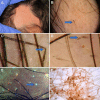Alternaria scalp infection in a patient with alopecia areata. Coexistence or causative relationship?
- PMID: 23329992
- PMCID: PMC3543859
- DOI: 10.3315/jdcr.2012.1120
Alternaria scalp infection in a patient with alopecia areata. Coexistence or causative relationship?
Abstract
Background: Alopecia areata is an autoimmune disease that is affecting anagen hair follicles. The triggers of autoimmunity in patients with alopecia areata remain unknown.
Main observation: A 13-year-old boy developed multiple hairless patches of focal hair loss with typical clinical and trichoscopy features of alopecia areata. Mycology examination of the scalp hair and epidermal scrapings reveled massive growth of Alternaria chlamydospora.
Conclusion: We hypothesize that fungal antigens (e.g. antigens involved in fungal melanin synthesis) may be possible triggers, contributing to autoimmune reactions in patients with alopecia areata. We discuss research data, which may indirectly support this hypothesis, however the concept has yet to be verified.
Keywords: Alternaria; IgE; Wood’s light; allergy; alopecia areata; autoimmunity; dermoscopy; fluorescence; fungus; hair; infection; melanin; pathogenesis; phaeohyphomycosis; tines capitis; trichoscopy.
Figures

Similar articles
-
Trichotillomania: Bizzare Patern of Hair Loss at 11-Year-old Girl.Acta Dermatovenerol Croat. 2016 Jun;24(2):150-3. Acta Dermatovenerol Croat. 2016. PMID: 27477178
-
Use of trichoscopy for the diagnosis of alopecia areata coexisting with primary scarring alopecia in a female hair loss patient.J Dermatol. 2019 May;46(5):418-421. doi: 10.1111/1346-8138.14841. Epub 2019 Mar 7. J Dermatol. 2019. PMID: 30843255
-
Sequential cyclic changes of hair roots revealed by dermoscopy demonstrate a progressive mechanism of diffuse alopecia areata over time.Exp Dermatol. 2020 Mar;29(3):223-230. doi: 10.1111/exd.13799. Epub 2018 Dec 5. Exp Dermatol. 2020. PMID: 30307062
-
Hair shafts in trichoscopy: clues for diagnosis of hair and scalp diseases.Dermatol Clin. 2013 Oct;31(4):695-708, x. doi: 10.1016/j.det.2013.06.007. Dermatol Clin. 2013. PMID: 24075554 Review.
-
Alopecia areata: A multifactorial autoimmune condition.J Autoimmun. 2019 Mar;98:74-85. doi: 10.1016/j.jaut.2018.12.001. Epub 2018 Dec 15. J Autoimmun. 2019. PMID: 30558963 Review.
Cited by
-
Construction of regulatory network for alopecia areata progression and identification of immune monitoring genes based on multiple machine-learning algorithms.Precis Clin Med. 2023 May 22;6(2):pbad009. doi: 10.1093/pcmedi/pbad009. eCollection 2023 Jun. Precis Clin Med. 2023. PMID: 37333624 Free PMC article.
-
Cutaneous alternariosis in a renal transplant patient successfully treated with posaconazole: Case report and literature review.Med Mycol Case Rep. 2017 Jan 21;15:16-20. doi: 10.1016/j.mmcr.2017.01.003. eCollection 2017 Mar. Med Mycol Case Rep. 2017. PMID: 28180057 Free PMC article.
-
The Human Skin Microbiome in Selected Cutaneous Diseases.Front Cell Infect Microbiol. 2022 Mar 7;12:834135. doi: 10.3389/fcimb.2022.834135. eCollection 2022. Front Cell Infect Microbiol. 2022. PMID: 35321316 Free PMC article. Review.
-
Gut-Skin Axis: Current Knowledge of the Interrelationship between Microbial Dysbiosis and Skin Conditions.Microorganisms. 2021 Feb 11;9(2):353. doi: 10.3390/microorganisms9020353. Microorganisms. 2021. PMID: 33670115 Free PMC article. Review.
-
Nonscarring Alopecia and Hypopigmented Lesions May Be Unusual Signs of Secondary Syphilis.Skin Appendage Disord. 2021 Apr;7(3):203-205. doi: 10.1159/000511577. Epub 2021 Feb 17. Skin Appendage Disord. 2021. PMID: 34055908 Free PMC article.
References
-
- Gilhar A, Etzioni A, Paus R. Alopecia areata. N Engl J Med. 2012;366:1515–1525. - PubMed
-
- Alkhalifah A. Alopecia areata update. Dermatol Clin. 2013;31:93–108. - PubMed
-
- Blaumeiser B, van der Goot I, Fimmers R, Hanneken S, Ritzmann S, Seymons K, Betz RC, Ruzicka T, Wienker TF, De Weert J, Lambert J, Kruse R, Nöthen MM. Familial aggregation of alopecia areata. J Am Acad Dermatol. 2006;54:627–632. - PubMed
-
- Petukhova L, Cabral RM, Mackay-Wiggan J, Clynes R, Christiano AM. The genetics of alopecia areata: What's new and how will it help our patients? Dermatol Ther. 2011;24:326–336. - PubMed
-
- Alzolibani AA, Zari S, Ahmed AA. Epidemiologic and genetic characteristics of alopecia areata (part 2) Acta Dermatovenerol Alp Panonica Adriat. 2012;21:15–19. - PubMed
Publication types
LinkOut - more resources
Full Text Sources
